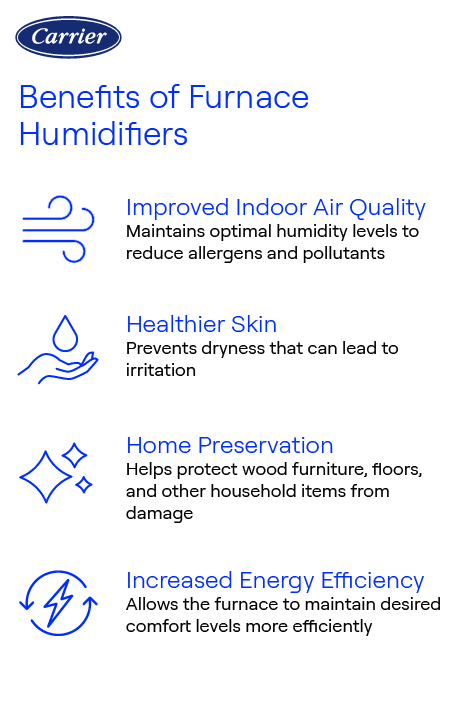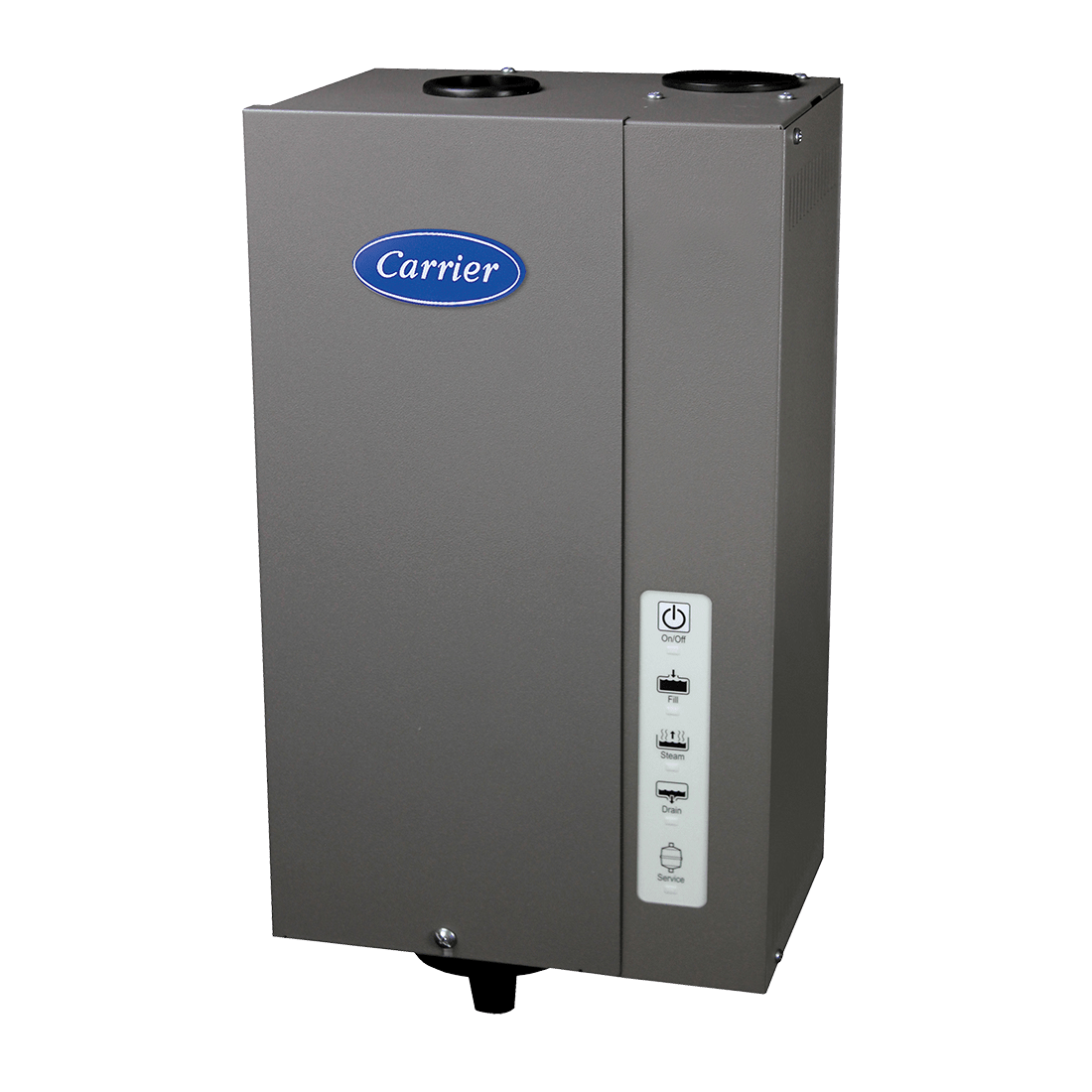Guide to Furnace Humidifiers
Carrier furnaces are well-known for their ability to keep you warm and cozy during the wintertime. But creating a comfortable indoor environment during colder months takes more than just heating the air in your home. That’s why adding a furnace humidifier – often called a whole-house or furnace mounted humidifier – to your HVAC system can be the key to your family’s comfort. Here’s why:
Because cooler air doesn’t hold as much moisture as warm air, it’s also important to have the right humidity level. Dry indoor air can cause skin irritation or scratchy throats, and may also damage wood furniture. It’s common to address this by using small, portable humidifiers, but they require frequent water refills, and ultimately don't support your whole home. To address this, get a whole house humidifier installation by a local Carrier technician added to your furnace to circulate moist air through ductwork to your entire home. And if your furnace has variable fan speeds, your system can take indoor moisture control to the next level.

Benefits of Whole Home Furnace Humidifiers

Health Reasons
Dry indoor air can cause a number of annoying discomforts such as dry and cracked skin, sore throat, eye irritation, and even dehydration. More concerning, the National Institutes of Health have reported that low humidity can contribute to higher incidences of allergies and other respiratory infections.1
Climate Conditions
Some areas of the country are more naturally prone to dry air. Cold-weather regions lead to drier indoor air because lower temperatures make it more difficult for water to vaporize and become airborne. This dry air can contribute to dry skin and lips and other dry-air issues already documented in this article.
Comfort
A whole-house furnace humidifier can improve your comfort by minimizing dry, itchy skin, dry nasal passages, chapped lips and more. Properly humidified air feels warmer than dry air, which may allow you to turn down your thermostat to help make your home more energy efficient. You can achieve these comfort benefits with an easy to clean humidifier that only requires annual maintenance and the convenience of not having to refill a water tank.
Budget
How A Furnace and Humidifier Together for Whole-Home Comfort
To see how a furnace and HVAC humidifier combination can work in your home, talk to your Carrier dealer during your next furnace service. Your dealer will be able to recommend a whole-house humidifier compatible with your current system to create the optimal humidity level for enhance comfort, protecting wood furnishings, and improving indoor air quality. If you are most concerned with comfort and furnishings, you should be targeting a range of 30 to 50 percent relative indoor humidity.
A furnace humidifier is attached to your furnace or duct system and includes a water source. Indoor air flows through the humidifier where it absorbs moisture and returns to your home as warm, humidified air from your furnace. Furnaces with a connected HVAC humidifier can control the moisture level throughout your home. Doing so can make the air feel warmer, which allows your system to operate at a lower temperature and can help save on energy costs. This type of whole-home humidification cannot be reliably achieved using a portable room humidifier.
3 Types of Furnace Humidifiers
Once you’ve decided to improve your comfort with a furnace and humidifier setup, you’ll need to make another decision – what type of whole house humidifier best fits your needs. There are three different types of furnace humidifiers: steam humidifiers, bypass humidifiers, and fan humidifiers.
“A steam humidifier adds moisture to your home by generating steam and releasing it into the air, which allows for precise control of humidity levels,” Kevin Dickson, president of Energy Services Air Conditioning, Heating and Electrical in Naperville, Illinois, said. “A bypass humidifier works a bit differently — it passes warm air from your heating system over an evaporative pad, adding moisture as the air moves through. There’s also a fan-powered humidifier, which uses a small fan to blow air across the water panel for faster and more consistent humidification."
Steam Humidifiers
What is it? A steam humidifier heats water until it creates steam which is released into your ventilation ductwork.
Who is it right for? These humidifiers are usually more expensive and use more energy, but are great for larger homes as they can deliver moisture to larger spaces more effectively than bypass or fan-powered humidifiers. Unlike bypass humidifiers, steam humidifiers can work independently of the HVAC system, which means they can humidify the air without the need for the furnace blower to be running.
Bypass Humidifiers
What is it? A bypass humidifier, also known as a flow-through humidifier, uses heated airflow from your furnace to absorb moisture from a pad inside the humidifier and distributes the humidified air throughout your home.
Who is it right for? Bypass humidifiers are great for those looking for energy efficiency as bypass humidifiers generally use minimal energy because they don’t have their own fans; they rely on the furnace’s blower, which can be more energy-efficient. Without a built-in fan, bypass humidifiers operate quietly, making them a good option for those who prefer minimal noise.
Fan Humidifiers
What is it? A fan humidifier uses its own fan to draw air into the humidifier unit where it absorbs moisture and then returns the humidified air to your duct system.
Who is it right for? Fan-powered humidifiers are often a middle ground between bypass and steam humidifiers. They are more powerful and efficient than bypass models but generally more affordable and easier to maintain than steam humidifiers. Unlike bypass humidifiers, fan-powered models have built-in fans that actively blow air across a water panel, allowing them to add moisture to the air more quickly and efficiently.
“Each type has its own benefits depending on your home’s size, your heating system, and how precise you want the humidity control to be,” Dickson said. “As a dealer, we help homeowners choose the system that delivers the most comfort, protects their home, and works efficiently with their existing HVAC setup.”
There is another humidifier option homeowners seek out – portable room humidifiers. While portable models can be less expensive initially, they don’t provide a whole-home solution and they require daily refilling and frequent cleaning.

Drawbacks for Whole Home Furnace Humidifiers
So far, we’ve covered many reasons why a furnace humidifier might be a great addition to your comfort system. Increased comfort, protecting wood furnishings and potentially improving indoor air quality to name a few. However, furnace humidifiers do have some potential downsides. That’s why it’s important to understand the HVAC humidifier pros and cons before making your decision.
A furnace humidifier can be a prone to mineral build-up and bacteria or mold growth in the humidifier and evaporator pad. Leaking water lines or clogged drain lines from the humidifier are potential issues as well. These types of issues can be mitigated with proper maintenance and annual inspections. While furnace humidifiers are not an absolute necessity, they do offer a number of benefits that make the effort and expense worthwhile.>
Choosing the Best Whole Home Humidifier For Furnace

The best whole house humidifier for your home will provide enhanced comfort, minimal maintenance and will be sized to support humidity control for the entire coverage area of your home. Most offer the convenience of a continuous water supply so you won’t need to worry about refilling a tank, and some models include digital control over humidity levels. If you are currently thinking about buying a furnace, now would be a great time to consider this option.
If whole-house humidifiers are out of your budget you can try looking for a portable model to provide comfort in specific rooms. A portable humidifier will need to be refilled often – as an example, a smaller model that can take one gallon of water might need to be refilled after 36 hours of operation. And they won’t provide comfort, air quality and efficiency benefits similar to those provided by a whole-house furnace humidifier. If you think your family might benefit from installing a furnace humidifier, find a Carrier dealer in your area and make an appointment to today.
Frequently Asked Questions About Furnace Humidifiers
Explore Carrier Humidifiers
Consider a Carrier humidifier to maintain ideal humidity levels and enhance comfort in your home. Carrier humidifiers help prevent dry skin, static electricity, and respiratory issues by adding moisture to the air, especially in the winter months. They are designed for quiet operation and energy efficiency, ensuring consistent humidity control without increasing energy costs. With reliable performance and easy integration into your HVAC system, Carrier humidifiers promote a healthier, more comfortable living environment year-round.
Learn More About HVAC Humidifiers
- Choosing the best humidifier for your home
- Cost to buy or replace a whole-home humidifier
- Humidifier uses: Should I Get One?
- What are whole-home humidifiers & how do they work?
- Learn the difference between a humidifier vs dehumidifier
- Discover what humidity should be house be at?




